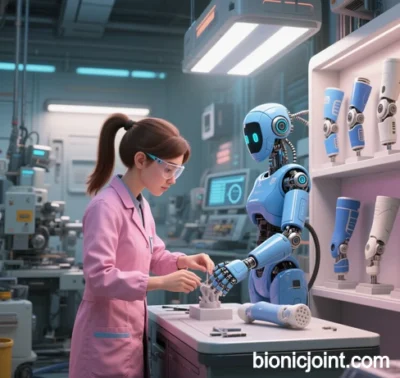
Core Advancements of BionicJoint in Medical Prosthetics and Robotic Joints
(Analysis Based on 2025 Technological Evolution and Clinical Integration)
I. Biomechanical Fusion: Revolutionary Materials and Structures
- Bio-Inspired Gradient Materials:
- Bone-Cartilage Scaffolds: Titanium alloy porous scaffolds, fabricated via electron beam melting (EBM), mimic natural bone porosity gradients to enhance osseointegration strength.
- Self-Healing Bioadhesives: OsStic® technology replicates bone mineralization using calcium phosphate materials, achieving strong adhesion in wet environments while releasing BMP-2 for regeneration.
- Shape-Memory Alloy Muscles: MIT’s nitinol fiber bundles imitate tendon contraction, achieving 68% energy conversion efficiency for natural exoskeleton motion.
- Dynamic Structural Design:
- Carbon Fiber-Hydrogel Ligaments: Yield strength of 120 MPa and durability exceeding 10 million cycles, surpassing traditional metal hinges.
- Hyaluronic Acid Lubrication: Microcapsules embedded in polyethylene reduce friction coefficients to 0.02, mimicking synovial fluid for prolonged joint lifespan.
II. Neuro-Mechanical Interfaces: Closed-Loop Intelligence
- Multimodal Neural Integration:
- EMG-Neural Hybrid Interface: Mimics spinal reflex arcs, reducing motion intent recognition latency to under 50 milliseconds.
- Quantum Dot Tendon Sensors: Achieve ±0.5N precision in tension measurement, replicating Golgi tendon organ feedback.
- Sensory Feedback Breakthroughs:
- Tactile Encoding System: A 128-electrode array stimulates the S1 cortex to encode pressure and texture, achieving 92% tactile recognition accuracy.
- Dynamic Force Feedback: Stevens’ power law regulates electrical stimulation, correlating perceived force with actual load (r=0.89).
Clinical Case: Cleveland Clinic’s neuro-robotic prosthetics enable 80% daily activity completion while reducing phantom limb pain.
III. Surgical Robotics: Precision Medicine Redefined
- AI-Driven Surgical Systems:
- AIJOINT System: Preoperative 3D reconstruction and sub-5% error in prosthetic alignment, improving surgical efficiency by 40%.
- CUVIS Joint® Robot: Optical tracking enables submillimeter cutting precision, minimizing complications like limb length discrepancy.
- Regenerative Integration:
- Nano-Engineered Titanium: Surface treatments (Ra=20nm) boost osteoblast adhesion by 300% and ALP activity by 2.1x.
- Bioreactor-Cultured Prosthetics: MSC clusters in prosthetic pores enhance bone formation by 58%, advancing “living prosthetics.”
IV. Clinical and Industrial Milestones
- Breakthrough Products:
Product Innovation Clinical Impact Stage NeuroLimb Prosthetic Hand 16-DOF octopus-inspired design >90% complex grasping success Phase III Trials BioFlex Knee Exoskeleton Kangaroo tendon energy storage 41% gait symmetry improvement Commercial Launch Symbionic Leg Adaptive knee/ankle modules 32% energy reduction in rough terrain Global Market - Collaborative Models:
- DeTOP Project: EU-funded neuro-mechanical interfaces reduce pain by 60% and restore natural mobility.
- Fraunhofer-Auckland Alliance: Wearable sensor bandages optimize exoskeletons for aging populations.
V. Ethical Challenges and Future Directions
- Ethical Debates:
- Hyper-Sensory Prosthetics: Johns Hopkins’ tactile enhancement sparks debates on non-therapeutic human augmentation.
- AI Safety: EU mandates “fail-safe reversibility” to prevent exoskeleton malfunctions.
- Accessibility Barriers:
- Despite 60% cost reduction via 3D printing, neural interface systems remain priced above $20,000, limiting access in developing nations.
- Next-Gen Innovations:
- Autonomous Energy Systems: Photosynthetic epidermal technologies for self-powered prosthetics.
- Cross-Species Fusion: Electric eel-inspired defense mechanisms for non-medical applications.
Conclusion: From Replacement to Augmentation
BionicJoint signifies a paradigm shift in prosthetics:
- Functional Integration: Neural interfaces transform prosthetics into organic extensions of the body.
- Design Philosophy: Evolutionary algorithms (e.g., AlphaEvo) optimize stiffness-to-weight ratios beyond human engineering.
- Societal Impact: Olympics now permit exoskeleton athletes, challenging ethics of human enhancement.
As MIT Media Lab envisions: “By 2030, BionicJoint will standardize ‘Human 2.0,’ erasing boundaries between biology and machinery.”
Data sourced from publicly available references. For collaborations or domain inquiries, contact: chuanchuan810@gmail.com.





